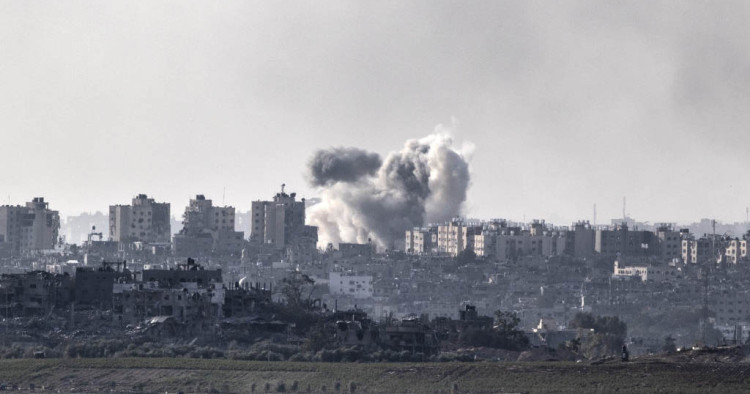Contents:
- "Second phase" of Israel’s war on Hamas begins
- Israeli military adopts more dynamic approach to its assault on Hamas
- Any swords into ploughshares? The challenge of the current conflict
- The Biden administration tries to secure safe passage for US citizens trapped in Gaza
- Humanitarian situation dire as Israel chokes Gaza and Netanyahu employs increasingly extremist rhetoric
- Worsening violence and regional escalation will only fuel future terrorism
“Second phase” of Israel’s war on Hamas begins
Paul Scham
Non-Resident Scholar

-
Prime Minister Netanyahu has described Israel’s assault on Gaza as the Jewish state’s “Second War of Independence” and indicated that this conflict would not be short.
-
Both domestic and international pressure to prioritize the hostages, perhaps even including some sort of ceasefire, has been building, alongside opposite internal demands for continuing the massive retribution against Hamas.
Over the weekend, Israel launched the “second phase” of its response to the Hamas attack of Oct. 7, which killed more than 1,400 Israelis and captured over 230, still held as hostages in Gaza by Hamas and other groups. Israel has repeatedly announced that it would “destroy” the Hamas regime in Gaza and to that end has mobilized 360,000 reservists. It reports that it has hit around 5,000 targets so far in its bombing campaign, which has continued nonstop for the past three weeks. The death toll among Palestinians has passed 8,300, mostly women and children, the Gaza Health Ministry said Monday. In the West Bank, armed groups of settlers are reportedly attacking Palestinians, with little interference from the Israeli army.
Israel has made clear that it has no appetite for a second front on its northern border, although the Lebanese Shi’a militia Hezbollah, closely allied with Iran, has threatened a full-scale assault if Israel launches a ground invasion of Gaza. The United States, which has moved two carrier strike groups to the eastern Mediterranean, presumably to deter or, if necessary, counter any such “second front,” has reportedly also been applying heavy pressure on Israel to clarify its war aims, limit its physical presence in Gaza, and prioritize the return of hostages. Hezbollah and the Israeli military have been launching a limited number of rockets daily, but so far, both sides are still exercising restraint.
At a press conference Saturday announcing the next stage of Israel’s response, Prime Minister Benjamin Netanyahu described Israel’s assault on Gaza as the Jewish state’s “Second War of Independence” and indicated that this conflict would not be short. He stressed that Israel’s equally important aim, along with the destruction of Hamas, is to safely repatriate the hostages. He and Defense Minister Yoav Gallant have separately met with families of the hostages but did not address the widespread skepticism that achieving one aim may preclude the other. The families have mobilized a large portion of Israeli public opinion in support of their aim to prioritize a return of the hostages. Rumors of a possible deal brokered by Qatar that would exchange the 230 hostages for over 5,000 Palestinian prisoners held in Israeli jails seem to have died down, though discussions are apparently continuing.
Two days into the “second phase,” it is clear that the latest ground incursions are not yet the anticipated all-out assault. Israel has apparently seized a small area in northwest Gaza for use as a staging ground, and another small force of tanks and infantry has entered just south of Gaza City. The intention seems to be to surround and lay siege to Gaza City, located in the north-central part of the enclave, where Hamas’s main bases are believed to be located. This strategy may partly be an attempt to avoid the appearance of a full-scale assault, potentially deterring escalation from Hezbollah and other Iranian allies.
At the same time, Israel is preventing sufficient food and fuel supplies from entering the Strip, while claiming there is no humanitarian crisis, contrary to the increasingly panicked appeals by international aid agencies. Israel contends that Hamas has accumulated large reserves of such staples, which it should distribute to the population. Essentially both sides are holding the 2.3 million Gazans hostage.
Israeli strategy has been incoherent and contradictory with regard to Hamas ever since the latter took control of Gaza in 2007, and this has only increased since Oct. 7. Both domestic and international pressure to prioritize the hostages, perhaps even including some sort of ceasefire, has been building, alongside opposite internal demands for continuing the massive retribution against Hamas. The current government knows it is highly unpopular and will face searching inquiries as to its failures the moment the war is over. How these factors are influencing military strategy is as yet unclear.
Israeli military adopts more dynamic approach to its assault on Hamas
Bilal Y. Saab
Senior Fellow and Founding Director of the Defense and Security Program

-
In lieu of a massive ground incursion, the Israel Defense Forces’ (IDF) “second phase” —incorporating repeat special forces raids and massive bombardment — will seek to encircle and bleed Hamas until the threat it poses to Israeli population centers becomes negligible or manageable.
-
The potential for significant collateral damage and regional escalation remains high, but it will be lower than that associated with a full-fledged ground invasion.
The Israeli government won’t admit it publicly, but the goalposts in its war against Hamas have moved. Reason has settled in, for now: In lieu of a massive ground incursion, the Israel Defense Forces’ (IDF) “second phase” will seek to encircle and bleed Hamas until the threat it poses to Israeli population centers becomes negligible or manageable.
This will be a more dynamic approach, one that incorporates raids by Israeli special forces to collect better intelligence on the enemy, methodically go after its leadership and command-and-control centers once in possession of that intelligence, retreat, call for aerial bombardment, and repeat until Hamas is sufficiently weakened. It’s a sustained pressure campaign.
Assuming this is the strategy the IDF has adopted, it is rational, because:
- It is much less risky to the IDF soldiers.
- It could reduce collateral damage, which is Washington’s chief concern right now. U.S. President Joe Biden was crystal clear with Prime Minister Benjamin Netanyahu when he urged him to exercise restraint to limit the loss of innocent Palestinian life and prevent regional escalation. Israel simply cannot ignore America’s preferences because it relies on it for military assistance and diplomatic cover. The last thing the United States wants is a war with Iran that torpedoes its new China-centered priorities.
- It leaves hope for diplomacy and the possibility of a prisoner swap, partial or full. It also could spare the lives of dozens of international hostages in the hands of Hamas.
- Finally, it might reduce the chances of another front by Iran and Hezbollah against the IDF, be it in Lebanon or Syria. In theory, this approach is less escalatory.
None of this means that the IDF’s second phase is without challenges and risks. But it’s all relative. The potential for significant collateral damage and regional escalation is still high. It’s just lower than that associated with a full-fledged ground incursion.
Any swords into ploughshares? The challenge of the current conflict
Paul Salem
President and CEO

-
Even as Israel has begun to expand its ground incursions, they have remained limited, and this may point to the pattern of the conflict for the coming months: continued overall siege and aerial bombardment, but with patch-by-patch ground operations to try to find and defeat Hamas fighters and close off their tunnels — aiming to clear one area before moving to the next.
-
The only long-term way of building security and stability, and reducing violence for Palestinians and Israelis alike, is to create hope and establish a political pathway for both sides.
Four weeks since Hamas’ attack on Israel and the start of the latter’s retaliatory military operation, the ultimate outlines of Israel’s war plan in Gaza remain unclear. The declared aim is to destroy Hamas — but that runs counter to the second goal of convincing it to release over 200 hostages. The first aim would require a full re-occupation of the Gaza Strip, but it is not clear if that is militarily achievable. Even if it were, the human, political, and economic costs to Israel over the coming weeks and months may not continue to seem worth it to Israelis, especially as Hamas presumably has long prepared for just such a battle, and the steadily rising costs for Palestinian civilians will dramatically increase regional and international pressure on Israel to stop. Pursuing the first aim also carries a substantial risk that if Israel is making real progress toward defeating Hamas, the likelihood of Iran opening a full second front — via Hezbollah and other proxies in Syria — becomes quite high.
Israel seems to be cognizant of these competing pressures, having postponed any ground invasion for three weeks, and even as it has begun to expand its ground incursions, they remain limited, rather than a full-scale ground assault. Indeed, this might be the pattern of the conflict for the coming months: continued overall siege and aerial bombardment, but with patch-by-patch ground operations to try to find and defeat Hamas fighters and close off their tunnels — aiming to clear one area before moving to the next. In such a pattern, the war would be set to go on for many months, with military deaths on both sides and thousands more Palestinian civilians killed, but likely no decisive military outcome.
One potential scenario is that after months of fighting, Israel will control one part of Gaza while Hamas retains control of another, with both sides having fought each other to exhaustion as a desperate and devastated civilian population continues to cry out for help. At that point, the two might engage in prisoner and hostage exchanges and try to agree to some new truce arrangements. But this will not resolve any of the underlying conditions nor buy any lasting peace.
In the long term, this conflict is between two people struggling over whether and how to share the small piece of real estate that they both call home. There is no military solution, only a political one that involves something resembling a two-state solution. Are there leaders in Israel, Palestine, the Arab world, and the U.S. that can see that as well and make it happen?
This is an excerpt from a longer version of the piece, which appeared on the MEI website.
Follow on Twitter: @paul_salem
The Biden administration tries to secure safe passage for US citizens trapped in Gaza
Brian Katulis
Vice President of Policy

-
U.S. diplomacy with actors in the region is trying to help secure the release of more than 200 hostages as well as hundreds of American citizens still trapped in the Gaza Strip.
-
As the military conflict in Gaza escalates, the risks increase for U.S. citizens, hostages, and Palestinian civilians.
The brutal war between Israel and Hamas in the Gaza Strip continues to create fresh dangers and uncertainties across the wider Middle East region. Israel expanded its military operations in Gaza this past weekend, moving into a new phase with operations on the ground.
The initial Hamas attack on Oct. 7 killed more Israelis in one day than during the nearly four and a half years of the Second Intifada, from 2000 to 2005. More Palestinians have likely been killed in the three weeks of Israeli airstrikes on Gaza than in all of the conflicts in Gaza combined since the 2005 Israeli withdrawal. A series of stepped-up strikes against Israel from Hezbollah and other Iran-affiliated groups from the north in Lebanon and Syria, along with increased attacks and threats against the United States’ military presence in the Middle East, risk a wider conflagration.
This crisis has prompted the U.S. to step up its military and diplomatic engagement in the Middle East in an effort to achieve progress on five main goals:
- Support Israel’s self-defense and objective of eliminating threats posed by Hamas and other groups;
- Secure the safe return of hostages and American citizens trapped in Gaza;
- Prevent a wider regional war;
- Protect civilians and respond to a growing humanitarian crisis in Gaza; and
- Maintain strong working relationships with Arab countries and others involved in managing the fallout as well as planning for the future.
This past weekend, a top focus of U.S. officials was ongoing negotiations to secure the release of more than 200 people held hostage in talks that Qatar is helping broker with Hamas and other actors in the Gaza Strip. Another top priority is diplomatic efforts to secure the safe passage of more than 500 U.S. citizens believed to still be trapped in the Gaza Strip.
Over the weekend, U.S. national security advisor Jake Sullivan was asked about this issue and responded by saying, “…we are facing a similar situation with the American citizens and other foreign nationals who are trapped in Gaza. It is true the Egyptians are prepared to allow American citizens and foreign nationals to come through the Rafah gate into Egypt. The Israelis have no issue with that. Hamas has been preventing their departure and making a series of demands.” He added, “We are trying to work through those [Hamas’ demands] to get to a point where we have secured the safe passage of any American in Gaza who wants to leave. We are in contact with them on a near-daily basis. We will continue to stay focused on this.”
Sullivan specifically referred to enabling American citizens to leave Gaza as an “equal priority” to getting hostages out. There are many reasons for this, particularly since the top job of the U.S. government is to do its utmost to protect its own citizens. As the war expands in Gaza, the risks increase that Israeli military strikes or actions by Hamas and other groups will lead to the loss of American lives.
In my own discussions with Palestinians living in Gaza, some expressed doubt that Hamas was causing the holdup in gaining the secure passage of U.S. citizens and others. This could be the usual fog of war and complicated diplomacy. In any case, it is one of many issues that U.S. officials are trying to address while juggling multiple other priorities in the region, including trying to avoid a wider regional conflict and securing humanitarian aid to Palestinians in Gaza.
Follow on Twitter: @Katulis
Humanitarian situation dire as Israel chokes Gaza and Netanyahu employs increasingly extremist rhetoric
Nasir Almasri
Graduate Fellow

-
With Benjamin Netanyahu’s anti-Palestinian rhetoric growing more extreme, Israel for now continues to make only limited incursions into Gaza, prioritizing cutting off fuel, water, and aid to the Strip in an attempt to choke the population and get it to turn against Hamas.
-
In 24 days, Israeli airstrikes have killed more than 8,000, internally displaced 1.4 million, and destroyed much of Gaza’s critical infrastructure; but less than 5% of the necessary humanitarian aid is reaching Gazans.
Israel’s military operation has killed over 8,300 Palestinians — at least 3,400 children — and wounded 20,000 others in Gaza, with an estimated 1,400 bodies lying under rubble. Although U.S. President Joe Biden cast doubt on these numbers, humanitarian organizations say they are reliable. Almost two-thirds of Gaza’s 2.3 million residents have been internally displaced. Israel’s ferocious aerial bombardment has devastated infrastructure in Gaza and levelled entire neighborhoods, destroying over 40% of homes, and damaging countless healthcare, religious, and educational facilities. Having already cut off food, water, and fuel to Gaza’s population, Israel continues to heavily restrict the entry of humanitarian aid to Gaza. Since Oct. 7, a total of 117 trucks have entered Gaza — a small fraction of the 100 trucks per day United Nations officials say are minimally required to meet the basic needs of Gaza’s population. President Biden has urged Israel to allow more aid trucks into Gaza.
The humanitarian catastrophe will worsen in the coming weeks as a consequence of Israel’s announced plans for a ground invasion. In parallel with a limited Israeli incursion over the weekend, Israel cut internet and communications access to the Strip, which was eventually restored, reportedly under U.S. pressure. Israel seems to be deliberately relying on a worsening humanitarian situation as its strategy to get Gazans to turn against the entrenched militant group.
In his announcement of “phase two” of the military operation, Prime Minister Benjamin Netanyahu made comments that reflected this increasingly extreme approach. Indeed, although Israel has already killed thousands of Palestinian civilians, Netanyahu has additionally threatened the bombing of Gaza’s largest medical facility, Dar al-Shifa Hospital, which is sheltering around 40,000 injured and internally displaced persons, as well as al-Quds Hospital, which holds another 12,000 displaced. Israel continues to heavily target the areas surrounding the hospitals. More generally, the aerial bombardments this past weekend were more exhaustive than at any point in Israel’s 16-year blockade of Gaza. Moreover, reports verified Israeli use of white phosphorous last week, and new videos surfaced this past weekend showing Israel’s continued use of the incendiary weapon.
If the worsening humanitarian situation is Israel’s route to victory, it can only be overcome through U.S. pressure on Israel to negotiate a long-term ceasefire. The U.N. General Assembly passed a resolution on Oct. 27 calling for an immediate “humanitarian truce”; though without U.S. support, it seems unlikely to have any real consequences. President Biden continues to provide Israel with a blank check, while Rep. Cori Bush’s “Ceasefire Now” resolution has gained limited traction in Congress. Unless mass protests happening across the U.S. and the world or the reported dissent among some diplomats and practitioners within the State Department can put pressure on Congress or the Biden administration, Israel will continue to act with impunity.
Worsening violence and regional escalation will only fuel future terrorism
Charles Lister
Senior Fellow, Director of Syria and Countering Terrorism & Extremism programs

-
An ongoing dynamic of regional escalation places U.S. troops and interests under direct threat from Iranian militant proxies; in two weeks, U.S. bases in Iraq and Syria have been targeted 32 times, causing two dozen casualties and one death.
-
Many unknowns remain, but one thing appears certain: Hamas’ horrific attack on Oct. 7 and Israel’s subsequent response have created the conditions necessary for a whole new generation of terrorism across the region and beyond.
Hamas’ brutal terrorist attack on Israel on Oct. 7 — leaving 1,400 dead and 230 hostages in Gaza — set in motion a series of tragically predictable events that are now playing out. Hamas and allied groups in Gaza have launched nearly 10,000 rockets toward Israel and, amid Israeli airstrikes and ground incursions in Gaza and raids into the West Bank, spillover hostilities and violence have occurred in or been launched from Lebanon, Syria, Iraq, Egypt, and Yemen.
The sheer scale of the violence has created a humanitarian crisis in Gaza that is spiraling out of control. In the first six days after Hamas’ attack, Israel dropped at least 1,000 bombs per day on Gaza’s 365 square kilometers — one of the most densely populated regions of the world. In comparison, during its most intense months, the U.S.-led coalition against ISIS dropped roughly 85 bombs per day on targets across an expanse of territory nearly 100 times larger.
According to reporting by the United Nations, at least 8,000 people have been killed in Gaza — over 3,300 of them children — and 1.4 million Gazans (63% of the population) have been displaced. Amid a crippling humanitarian crisis, a total of just 117 aid trucks have entered Gaza via the Rafah Crossing since Oct. 21. That amounts to 2% of the normal aid supply pre-conflict, according to U.N. data. In the past three weeks, more children have been killed in hostilities — 99% of them in Gaza and the West Bank — than in every conflict zone in the world since 2019.
Israeli forces are now engaged in a third day of ground operations deep inside the Gaza Strip, reportedly reaching as far west as the Salah ad Din road, effectively splitting the territory in half, north to south. Primary targets will be the key population centers of Gaza City, Deir al-Balah, Khan Younis, and Rafah, where protracted and complex fighting will result. But the most difficult challenge will be Hamas’ “metro” of tunnels, thought to extend for more than 300 miles, some as deep as 230 feet underground. Israel’s most advanced bunker buster munitions can only penetrate 100 feet, so subterranean warfare will raise a multitude of risks. In some cases, Israel may resort to flooding tunnels, or blocking them with sophisticated but dangerous “sponge bombs”; but with hostages likely concealed in the tunnels, there are no good options.
In all likelihood, we are in the earliest days of a protracted war, whose consequences will worsen markedly in the coming weeks and months. Nobody has an interest in this becoming a two- or three-front conflict, but we are moving in that direction. Hezbollah is methodically escalating a measured campaign on Israel’s northern border, moving from launching targeted attacks on Israel Defense Forces posts to firing longer-range rockets into population centers. In two weeks, Hezbollah has lost 50 fighters in Israeli retaliatory strikes.
Attacks on Israel also continue from southwestern Syria, with the Syrian Army now directly involved in rocket attacks that have drawn repeated, heavy Israeli airstrikes on three Syrian military bases in Daraa. Israel has also repeatedly struck Syria’s two international airports, Damascus and Aleppo. Yemen’s Houthis have launched two long-range aerial attacks aimed at Israel involving loitering munitions and cruise missiles, and they have killed several Saudi soldiers in a cross-border attack on Oct. 25.
This dynamic of regional escalation places U.S. troops and interests under direct threat from Iranian militant proxies. In two weeks, U.S. bases in Iraq and Syria have been targeted 32 times, causing two dozen casualties and one death. So far, U.S. aircraft have only responded once, on Oct. 27, but at least 10 Iranian-directed attacks have followed since.
Many unknowns remain, but one thing appears certain: Hamas’ horrific attack on Oct. 7 and Israel’s subsequent response have created the conditions necessary for a whole new generation of terrorism across the region and beyond. Far from eradicating Hamas, events today will spawn a future Hamas 2.0 and risk returning the Palestinian cause to the global jihadist agenda.
Follow on Twitter: @Charles_Lister
Photo by Mostafa Alkharouf/Anadolu via Getty Images
The Middle East Institute (MEI) is an independent, non-partisan, non-for-profit, educational organization. It does not engage in advocacy and its scholars’ opinions are their own. MEI welcomes financial donations, but retains sole editorial control over its work and its publications reflect only the authors’ views. For a listing of MEI donors, please click here.













